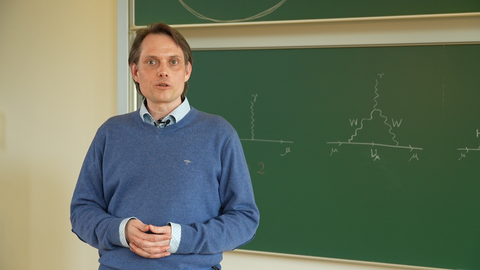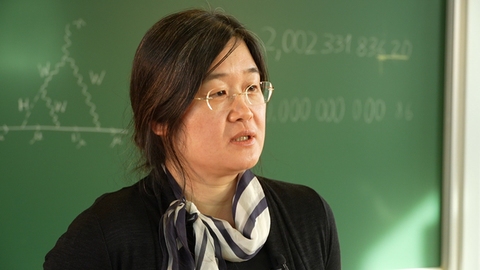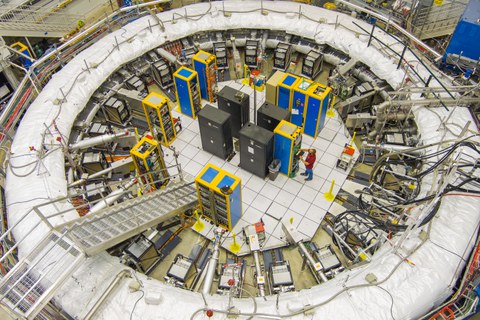28.08.2023
Neue Teilchen im Universum? Physiker:innen verbessern Messung zur Suche nach neuer Physik
Könnte das Verhalten der Myonen-Teilchen zur Entdeckung einer verborgenen Physik führen? Im zweiten Teil des Myon g-2 Experiments gab ein internationales Team von Wissenschaftler:innen des Fermilab (Illinois, USA) ihr lang erwartetes, verbessertes Messergebnis bekannt: Auf der Suche nach einer Begründung für das verheißungsvoll ungewöhnliche Verhalten des Myon konnte die Messgenauigkeit auf das Doppelte gesteigert werden. Von der TU Dresden begleiten Prof. Dominik Stöckinger (Direktor des Instituts für Kern- und Teilchenphysik) und seine Frau Dr.in Hyejung Stöckinger-Kim das theoretische Fundament dieses Mammutprojekts seit dessen Beginn in 2017.

Prof. Dominik Stöckinger
Myonen sind Elementarteilchen, die sich wie ein Kreisel drehen, wenn sie ein Magnetfeld passieren. Die Schnelligkeit der Kreiselbewegung hängt von der Stärke ihres inneren magnetischen Moments, von g-2, ab. Im Teilchenbeschleuniger des Fermilab in Illinois werden Myonen seit 2017 in großer Zahl hergestellt und untersucht. Mit beinahe Lichtgeschwindigkeit jagen sie im Vakuum durch den Beschleunigungsring bei -230°C, also kälter als der Neptun. Im April 2021 kam der Durchbruch: Das Myon verhielt sich in hochpräzisen Messungen anders als vom Standardmodell erwartet – was bedeutet das? So könnte die Entdeckung einer neuen Physik beginnen, denn seit August 2023 ist klar: Ein Fehler am Experiment ist es nicht.
Wer ist der unbekannte Tänzer?

Dr. Hyejung Stöckinger-Kim
Prof. Stöckinger und Dr.in Stöckinger-Kim sind seit Stunde Null an den Rechnungen des Myon g-2 Experiments beteiligt. „Das Verhalten des Myons lässt sich über den g-Faktor vorhersagen. Er ist im Standardmodell der Teilchenphysik festgehalten – dem weltweit anerkannten Modell zur Erklärung von Wechselwirkungen zwischen Teilchen“, erklärt Dr.in Stöckinger-Kim. Jenseits des Standardmodells offenbart sich die Welt einer neuen Physik. Ihr Mann führt aus: „Die Kreiselbewegung des Myons ist unterschiedlich, je nachdem, welche Teilchen in seiner Umgebung sind. Gewissermaßen tanzt das Myon mit den anderen Teilchen Tänze, die wir erkennen. Seit 20 Jahren werden die Berechnungen und Messungen immer genauer. Folgt man den Hypothesen von neuer Physik, könnten zum Beispiel Teilchen der dunklen Materie oder zusätzliche Higgs-Teilchen den Wert von g-2 beeinflussen. An der TU Dresden durchgeführte Berechnungen erlauben Rückschlüsse auf die Eigenschaften solcher möglichen Teilchen.“
Systematische Fehler ausgeschlossen
Nun ist das mit „g-2“ bezeichnete anomale magnetische Moment des Myons deutlich genauer gemessen als jemals zuvor. Mit der aktuellen Veröffentlichung der Beteiligten Forscher:innen zeigt sich ebenfalls, dass der Experimentaufbau fehlerfrei ist. Dank der Datenauswertung aus den letzten Jahren konnten Unsicherheiten auf den ungeheuer kleinen Wert von 1:5 Millionen gesenkt werden. Nun muss die theoretische Berechnung im Rahmen des Standardmodells eine entsprechende Genauigkeit erreichen, um die verlässliche Schlussfolgerung auf eine mögliche neue Physik zu erlauben. Hierzu sind internationale Anstrengungen im Gange. Noch ist offen, ob sich die Eigenschaften der Myonen vollständig durch Wechselwirkungen mit Photon, Elektron, Quarks, Neutrinos, Gluon, W-, Z- oder Higgs-Bosonen verstehen lassen, oder ob etwas Verborgenes auf das Myon wirkt.
Verborgene subatomare Kräfte
Bis 2025 will das Fermilab alle sechs Messjahre auswerten, um statistische Unsicherheiten weiter zu senken. Zugleich werden theoretische Physiker:innen die Berechnungen im Rahmen das Standardmodells verbessern. „Aus vielen Gründen sind wir sicher, dass unser derzeitiges Verständnis der Physik unvollständig ist. Es könnten zusätzliche Teilchen oder verborgene subatomare Kräfte existieren“, meint Prof. Stöckinger. Die Komplexität, diese Daten zu interpretieren, ist angewachsen. Ebenso die rechnerischen Schwierigkeiten im Rahmen der Theorie. Dr.in Stöckinger-Kim ist sich allerdings sicher: „Diese Auswertung könnte die Tür zu aufregenden neuen Bereichen der Wissenschaft öffnen.“
Weitere Informationen:
Über das FERMILAB NATIONAL ACCELERATOR LABORATORY (FRA)
Das Fermilab ist das erste Teilchenphysik- und Beschleunigerlabor in den USA mit mehr als 1.750 Mitarbeitern darunter Wissenschaftler, Forscher und Ingenieure aus der ganzen Welt. Das Fermilab arbeitet mit über 50 Ländern an physikalischen Experimenten zusammen und wird von der Fermi Research Alliance (FRA) für das US-Energieministerium verwaltet. FRA ist eine Partnerschaft zwischen der University of Chicago und der Universities Research Association, einem Zusammenschluss von 89 Forschungsuniversitäten.
Wissenschaftliches Webinar:
10. August 2023, 10:00 Central Time (US and Canada)
Neue Ergebnisse des Myon g-2 Experiment am Fermilab
Webinar Live:
https://fnal.zoom.us/j/93860521626?pwd=K0JpMWFVMjlxbE1yRVA4a2NIWWdrZz09
Passcode: 249396
Webinar Stream:
https://www.youtube.com/c/fermilab/featured Auf dem You-Tube-Kanal besteht keine Möglichkeit, Zuschauerfragen einzureichen.
Pressekonferenz:
10. August 2023, 12–13 Uhr CDT
Myon g-2 Sprecher Prof. Graziano Venanzoni gibt einen Überblick über das Myon g-2 Experiment, die Forschungsergebnisse und die Zukunft des Projekts. Ein question-and-answer schließt sich direkt an die Präsentation an.
https://fnal.zoom.us/j/93325378724?pwd=SnE3OUlYbVRyRElRcGVRNmliVjFBdz09
Passcode: 971495
Myon g-2 website: https://muon-g-2.fnal.gov/
Kontakt:
Prof. Dominik Stöckinger
Institut für Kern- und Teilchenphysik
